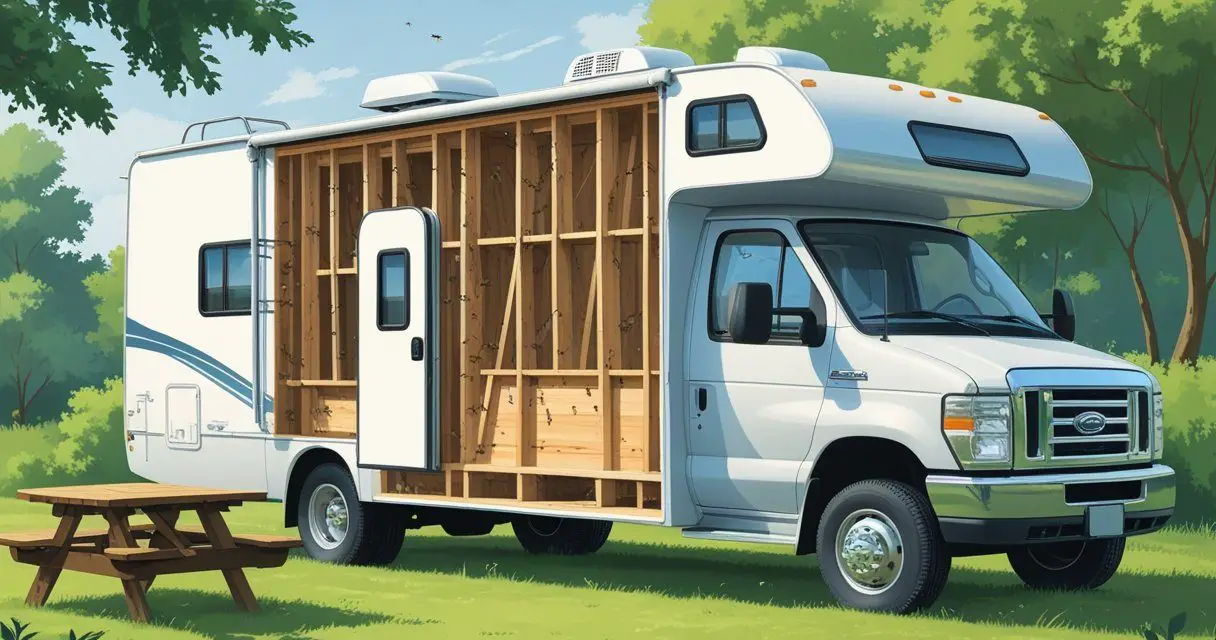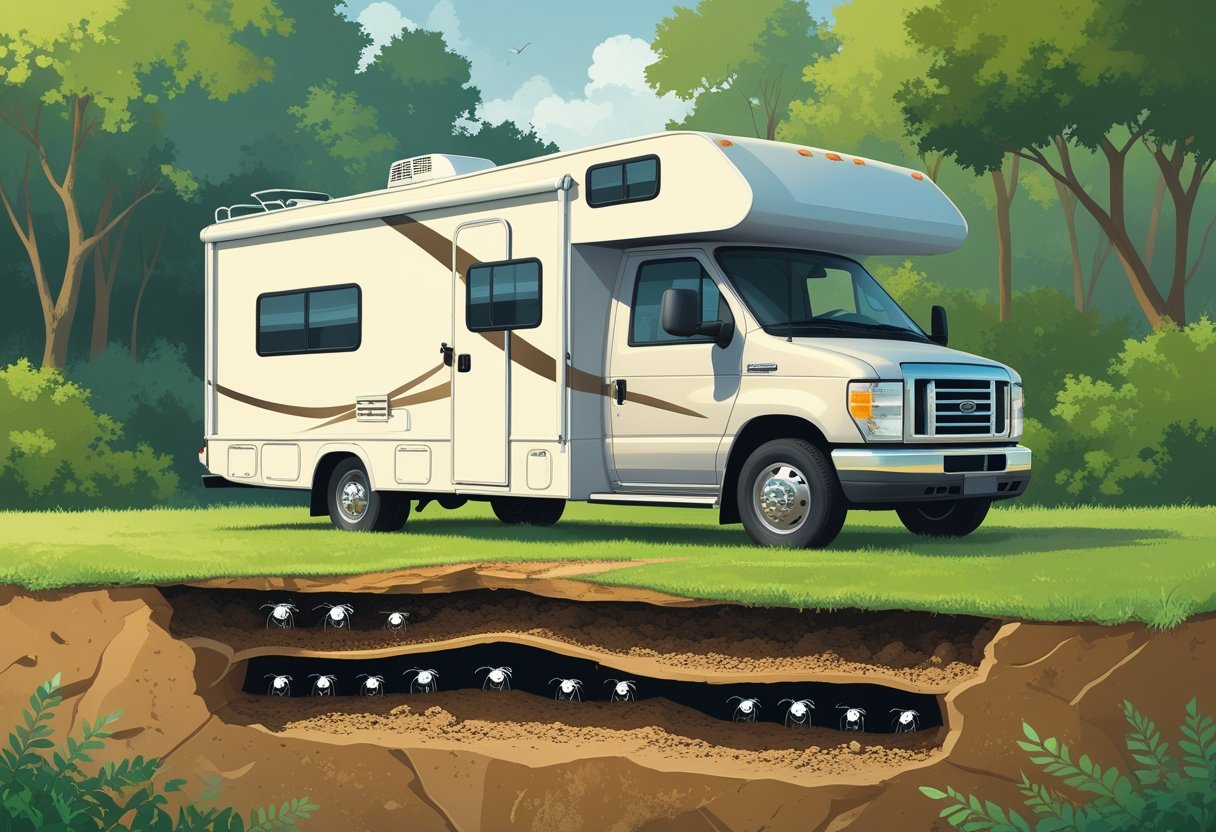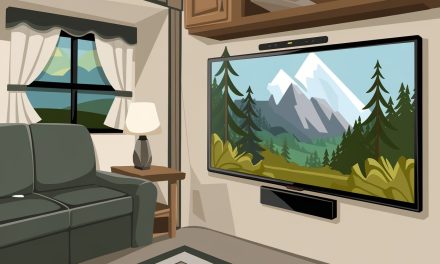Would you like to save this article?
Termites aren’t just a problem for houses; your RV can also be at risk. Even though RVs are built differently than regular homes, they often contain enough wood in their floors, walls, or frames to attract these pests.
If you own or use an RV, it’s important to know that termites can infest and damage your vehicle just like they do with traditional homes. Understanding this helps you better protect your investment and avoid expensive repairs down the road.
1) Yes, RVs can get termites despite less wood in modern builds.
You might think that because modern RVs use less wood, termites won’t be a problem. But termites can still find their way into your RV. Even newer models often have wooden cabinets, floors, or parts of the framework.
Termites are drawn to wood for food, and they don’t really care whether it’s inside a big house or a motorhome. If your RV has any wood, it’s possible for termites to start an infestation.
Some termites can travel up from the ground using mud tubes, climbing support pillars and reaching wood in your RV or attached structures. This means parking your RV in certain environments, like grassy or wooded areas, could increase the risk.
Manufactured wood and pressboard are also not safe from termites. They can chew through these materials just as easily as natural wood.
It doesn’t matter if your RV’s exterior is made of fiberglass, aluminum, or something else—if there’s wood inside, termites could target it. Regularly checking wooden areas in your RV might help you catch any early signs before things get serious.
2) Termites target wooden parts of your RV like cabinets and frames.
Even if your RV looks like it’s mostly metal or fiberglass on the outside, there’s still a good chance it has wood inside. Cabinets, floors, wall framing, and storage compartments often use wood or manufactured wood. Termites are drawn to these areas because that’s what they eat.
You might not notice any issues at first since termites usually hide inside wood, making their damage hard to spot. If you look closely, you might see small holes, piles of what looks like sawdust, or even tiny mud tubes leading to the wood.
Don’t forget to check underneath your RV as well, especially if you’re parked for a while. The underside might have exposed plywood or structure that termites can get into from the ground. It’s a smart idea to do a quick check of wood cabinets, closets, and corners from time to time.
If you keep your RV in a humid area, pay extra attention. Moisture and wood together are attractive to termites. Try to keep things dry inside and repair any leaks to make your RV less appealing to these pests.
3) Look for mud tubes on the exterior walls or under the RV.
One of the most obvious signs that termites might be in or around your RV is the presence of mud tubes. These are small, pencil-sized tunnels made from soil, wood particles, and termite saliva.
Mud tubes are usually built by subterranean termites as highways between their colony and any wood they’re eating. On an RV, you might spot these tubes around the tires, along exterior walls, or underneath the chassis. They can even show up near wheel wells or under steps.
Termites use the tubes to protect themselves while traveling between their nest and food sources. You should pay extra attention to spots where wooden parts of your RV meet the ground or are hard to see, like underbelly compartments.
If you see these mud tubes, it’s a good idea to inspect other parts of your RV for further signs of termites. Catching mud tubes early can help prevent more serious damage. Don’t just brush them away—take it as a warning that termites could be active nearby.
4) Swarmers or winged termites near lights indicate infestation.
If you spot winged termites, also called swarmers, hovering around lights or windows in your RV, it’s a sign you shouldn’t ignore. These termites are actually looking for places to start new colonies, and they’re drawn to light sources at night.
Seeing swarmers indoors is a red flag. It means there’s likely an active termite colony nearby, possibly even inside your vehicle. Swarmers don’t last long out in the open, so finding dead ones near windowsills or light fixtures is another possible warning sign.
Even if you just see a few, it’s worth a closer look because they usually don’t travel far from their nest. You might want to inspect for other signs of termites like mud tubes, damaged wood, or hollow sounds when you tap structures.
If you do see winged termites in your RV, consider reaching out to a pest professional. Early attention can help prevent further damage and keep your RV in good shape.
5) Small piles of white termite droppings are a major red flag.
If you ever spot tiny, pale piles that look a bit like sawdust or ground-up pepper inside your RV, pay close attention. These small mounds are actually termite droppings, also called frass. Termites push this waste out of their tunnels, and it tends to collect right below where they’re active.
It’s easy to brush these off as ordinary dust or dirt, but finding unexplained piles like this near wooden parts is a warning sign. Drywood termites are the most likely culprits in RVs, and their frass often has a lighter color—sometimes off-white or tan—depending on what they’ve been chewing.
You’ll usually find termite droppings near window sills, corners, or under furniture, especially close to any damaged wood. Don’t ignore these little piles, because they mean termites are quietly working behind the scenes. If you see something like this, it’s a good idea to take action fast and check for more termite activity or hire a professional.
6) Check for soft or hollow-sounding wood when tapped.
If you’re worried about termites in your RV, grab something light and gently tap on the wooden areas inside. Listen for a hollow or “papery” sound. Healthy wood should sound solid, while termite-damaged wood might sound empty underneath.
Don’t just listen—give it a push, too. Sometimes, the wood will feel soft or have a bit of give when you press on it. That’s another sign termites could be tunneling inside.
RVs often have hidden wooden framing, so pay attention to spots like door frames, cabinets, or window sills. If you find any spots that are unusually soft or make a dull thud, termites might be to blame.
Check for these signs especially in corners or behind thin paneling where termites are more likely to hide. If something feels off, it’s a good idea to check further or call a professional.
7) Termites can cause hidden damage without obvious surface signs.
Termites are really good at staying out of sight while they work. You probably won’t spot immediate, obvious clues if they get into your RV. Most of the damage they do happens behind walls, in wood framing, or in spots you don’t usually check.
Even if the outside of your RV looks fine, termites could still be doing damage inside. They chew through wood and other cellulose material, weakening the structure before you even notice anything is wrong. By the time there’s a visible problem, there might already be significant harm to the interior wood or support areas.
Keep in mind, they’re nicknamed “silent destroyers” for a reason. You might not see holes, sawdust, or mud tubes right away since termites often hide their entry points and don’t always leave obvious traces. That’s why regular inspections are important, especially if your RV sits idle for long periods.
Catching termite activity early makes repairs a lot easier. If you ignore it or wait for a big sign, the repairs could get expensive and complicated. Don’t just check the outside—look in cabinets, under flooring, and in storage spaces too.
8) Moving your RV regularly can help disrupt subterranean termite colonies.
If you keep your RV parked in one place for too long, you could be making it easier for subterranean termites to move in. These termites build underground tunnels to reach wood, and if your RV stays put, it becomes a stable target.
Regularly moving your RV interrupts their access points. Termites rely on stable ground contact to reach wooden parts, so driving away can break up their tunnels and force the worker termites to abandon the structure.
This doesn’t mean you have to be on the road constantly. Just relocating your RV now and then can weaken or even disrupt any developing termite colonies.
It’s still important to check for signs of termites, but regular movement stacks the odds in your favor. Moving your RV is a simple step that reduces the risk, especially if you’re in areas known for termite activity.
9) Drywood termites thrive in warmer climates and can invade parked RVs.
If you park your RV in warm or coastal regions, drywood termites are a real concern. These pests are most common in places with mild winters and high humidity. States like Florida, Texas, and California see more cases, but they aren’t limited to just those areas.
Drywood termites don’t need soil or extra moisture to survive. They get all their water from the wood and the humid air. This means even an RV that never touches the ground can still be at risk.
Your RV’s wooden cabinets, flooring, and furniture give drywood termites the shelter and food they need. Once inside, they can stay hidden for a long time, quietly causing damage without obvious signs.
Termite swarmers often appear in warmer months, looking for new places to start colonies. An RV parked outside or in a garage can easily attract these swarmers, especially if it’s left unused for a while.
Even if you aren’t in a known hotspot, moving or storing your RV in warmer climates increases the risk. Regular checks help spot problems before they get worse.
10) Termite damage can weaken structural integrity of your RV.
If termites get into your RV, they can slowly eat away at any wood or wood-based materials inside. This includes floors, support beams, wall paneling, and even furniture. While many RVs use lightweight or engineered woods, termites aren’t picky.
The small tunnels they create can leave wood looking fine on the outside, but hollowed out inside. Over time, this weakens the panels and supports your RV relies on.
You might first notice sagging in floors or soft spots where wood feels spongy. If the damage gets bad enough, it could lead to real safety concerns, like weakened walls or flooring that could give out.
Repairs for termite damage in RVs can get expensive, especially if you have to replace major sections. It’s also often hard to spot termite activity right away.
Keeping an eye out for possible signs and handling any issues quickly is important. Taking preventative steps, like regular inspections, will help you avoid big headaches down the road.







